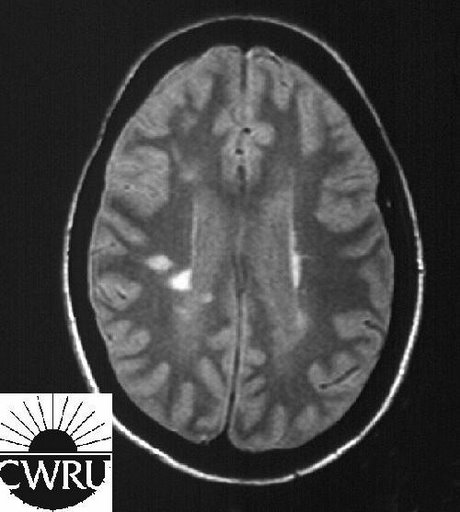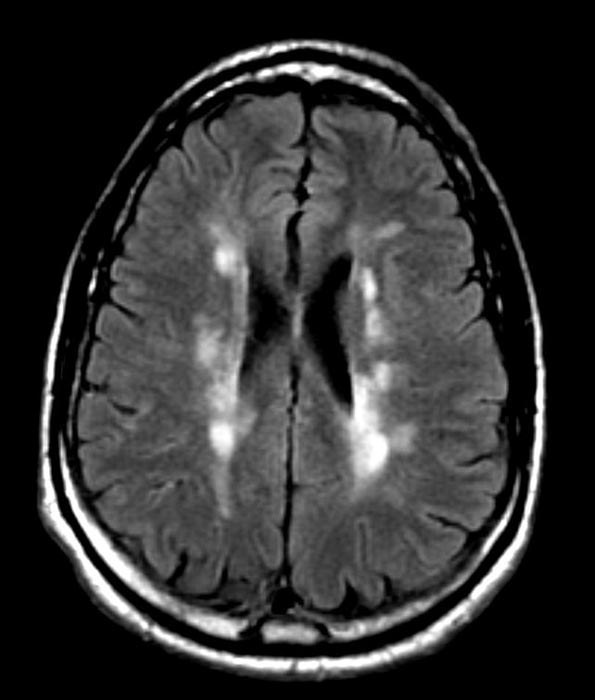Multiple sclerosis MRI
|
Multiple sclerosis Microchapters |
|
Diagnosis |
|---|
|
Treatment |
|
Case Studies |
|
Multiple sclerosis MRI On the Web |
|
American Roentgen Ray Society Images of Multiple sclerosis MRI |
|
Risk calculators and risk factors for Multiple sclerosis MRI |
Editor-In-Chief: C. Michael Gibson, M.S., M.D. [1]
Overview
On MRI, multiple sclerosis is characterized by cerebral plaques which are demyelinating areas.[1] These lesions are commonly ovoid, and located in periventricular white matter, cerebellum and brain stem.[2] These lesions are hyperintense on T2 sections of MRI.
MRI
The core of diagnosing MS is to show disseminating lesions in space and time. Before MRI becomes a common imaging technique for diagnosis MS, clinical presentation was the only tool. Nowadays new diagnostic criteria (mcDonald criteria) are focusing on MRI finding in addition to clinical presentation of patients.[3] MRI can show lesions better than CTscan. We can find typical white matter lesion in most of the MS patients. But these findings alone can’t confirm the diagnosis since there are so many conditions mimicing MS imaging especially ischemic lesions in patients more than 50 years old.[4]
On MRI, multiple sclerosis is characterized by cerebral plaques which are demyelinating areas.[1] These lesions are commonly ovoid, and located in periventricular white matter, cerebellum and brain stem.[2] These lesions are hyperintense on T2 sections of MRI. There are also gray matter lesions, presents as hypointensity in T2-weighted and are correlated with patients physical disability and brain atrophy.[5][6]
Spinal cords lesions are common in MS disease and are often symptomatic. These lesions are focal or diffuse, small land located mostly in the cervical spinal cord. spinal cord findings can be very helpful for diagnosing MS rather than brain MRI only.[7][8][3]
To differentiate acute and chronic lesion from each other we most know that acute lesions tends to be larger in size with poor defined border, but chronic lesion are smaller due to reduction of inflammation and edema and have sharp borders in imaging.[9]
-
T1-weighted MRI scans (post-contrast) of same brain slice at monthly intervals. Bright spots indicate active lesions.
-
Multiple Sclerosis
Patient #1
-
Multiple sclerosis
-
Multiple sclerosis
-
Multiple sclerosis
-
Multiple sclerosis
-
Multiple sclerosis
-
Multiple sclerosis
Patient #2: Contrast enchancement of several lesions indicates active disease
-
-
-
-
GAD enhanced T1
References
- ↑ 1.0 1.1 Trapp BD, Peterson J, Ransohoff RM, Rudick R, Mörk S, Bö L (January 1998). "Axonal transection in the lesions of multiple sclerosis". N. Engl. J. Med. 338 (5): 278–85. doi:10.1056/NEJM199801293380502. PMID 9445407.
- ↑ 2.0 2.1 Fazekas F, Barkhof F, Filippi M, Grossman RI, Li DK, McDonald WI, McFarland HF, Paty DW, Simon JH, Wolinsky JS, Miller DH (August 1999). "The contribution of magnetic resonance imaging to the diagnosis of multiple sclerosis". Neurology. 53 (3): 448–56. PMID 10449103.
- ↑ 3.0 3.1 McDonald WI, Compston A, Edan G, Goodkin D, Hartung HP, Lublin FD, McFarland HF, Paty DW, Polman CH, Reingold SC, Sandberg-Wollheim M, Sibley W, Thompson A, van den Noort S, Weinshenker BY, Wolinsky JS (July 2001). "Recommended diagnostic criteria for multiple sclerosis: guidelines from the International Panel on the diagnosis of multiple sclerosis". Ann. Neurol. 50 (1): 121–7. PMID 11456302.
- ↑ Offenbacher H, Fazekas F, Schmidt R, Freidl W, Flooh E, Payer F, Lechner H (May 1993). "Assessment of MRI criteria for a diagnosis of MS". Neurology. 43 (5): 905–9. PMID 8274173.
- ↑ Bakshi R, Shaikh ZA, Janardhan V (January 2000). "MRI T2 shortening ('black T2') in multiple sclerosis: frequency, location, and clinical correlation". Neuroreport. 11 (1): 15–21. PMID 10683822.
- ↑ Bakshi R, Dmochowski J, Shaikh ZA, Jacobs L (March 2001). "Gray matter T2 hypointensity is related to plaques and atrophy in the brains of multiple sclerosis patients". J. Neurol. Sci. 185 (1): 19–26. PMID 11266686.
- ↑ Lukas C, Sombekke MH, Bellenberg B, Hahn HK, Popescu V, Bendfeldt K, Radue EW, Gass A, Borgwardt SJ, Kappos L, Naegelin Y, Knol DL, Polman CH, Geurts JJ, Barkhof F, Vrenken H (November 2013). "Relevance of spinal cord abnormalities to clinical disability in multiple sclerosis: MR imaging findings in a large cohort of patients". Radiology. 269 (2): 542–52. doi:10.1148/radiol.13122566. PMID 23737540.
- ↑ Nijeholt GJ, van Walderveen MA, Castelijns JA, van Waesberghe JH, Polman C, Scheltens P, Rosier PF, Jongen PJ, Barkhof F (April 1998). "Brain and spinal cord abnormalities in multiple sclerosis. Correlation between MRI parameters, clinical subtypes and symptoms". Brain. 121 ( Pt 4): 687–97. PMID 9577394.
- ↑ Ingle GT, Thompson AJ, Miller DH (2002). "Magnetic resonance imaging in primary progressive multiple sclerosis". J Rehabil Res Dev. 39 (2): 261–71. PMID 12051469.











